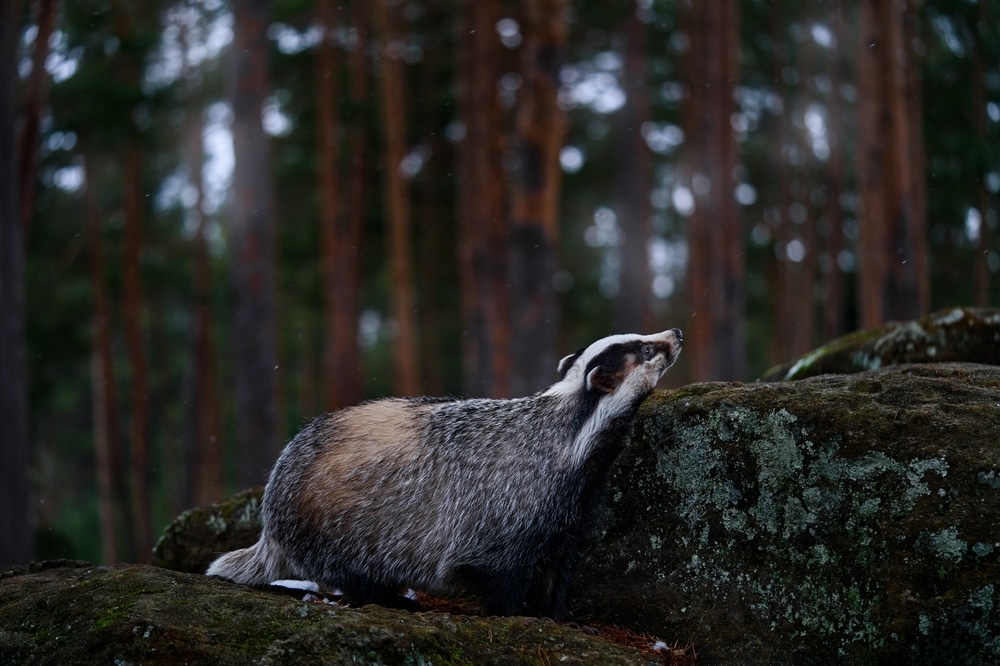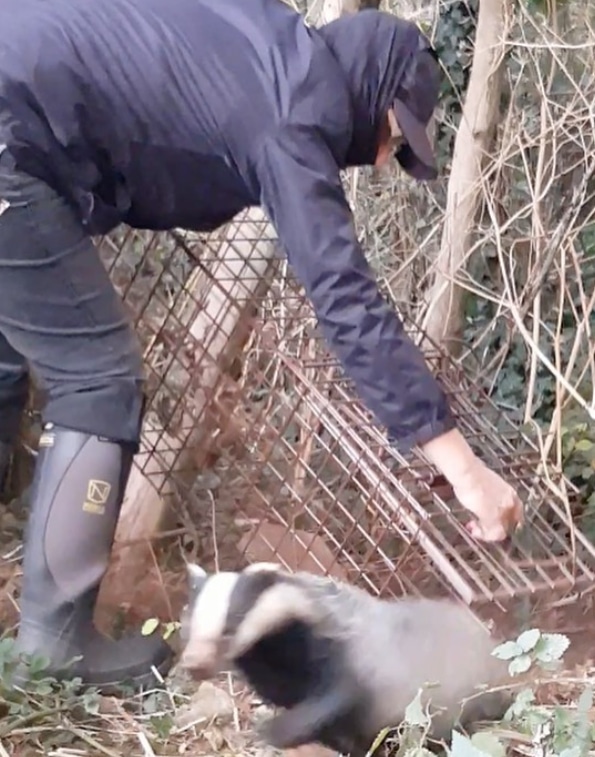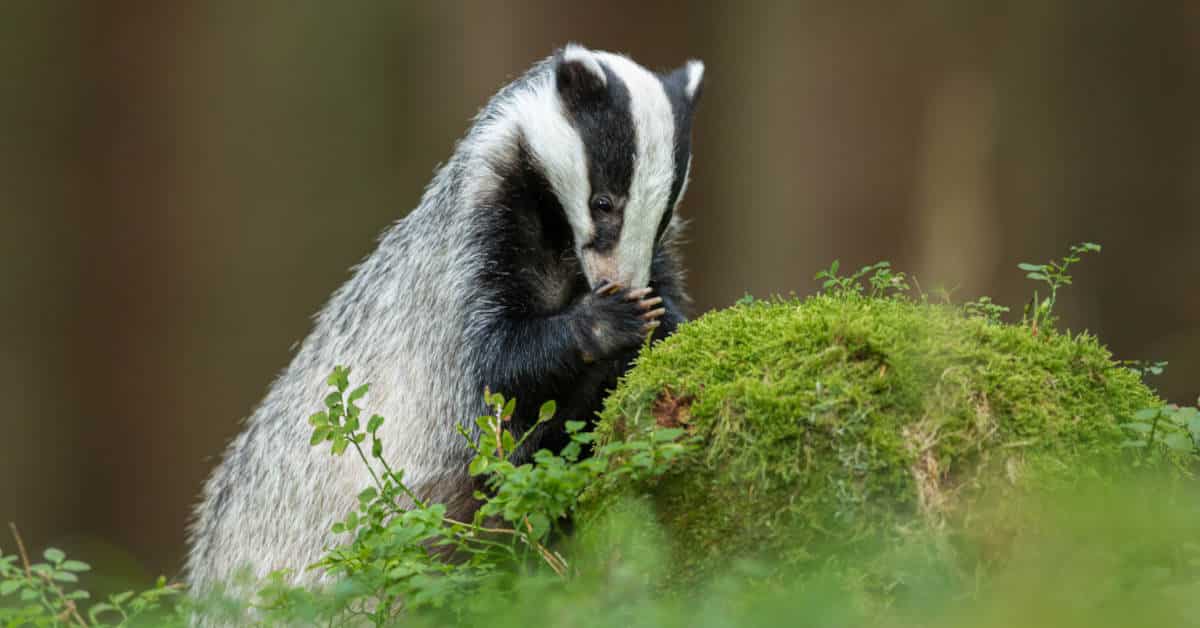The government has said that it will end the badger cull as we know it by 2026. But it will replace intensive four-year culling with a plan to murder 100% of badgers in specific areas of England.
Now a new report – authored by independent researchers, veterinarians, and epidemiologists – argues that these continued plans to cull badgers are unnecessary. They are devised in “a culture of flawed government veterinary beliefs“, and have no meaningful impact on combating bovine TB (bTB) in cows. The authors argue that an independent inquiry is needed. More than 210,000 badgers have needlessly died so far due to government policy.
Epidemiological culling
The policy of murdering 100% of badgers in one localised area is known as ‘epidemiological culling‘ (EC). This is different to the intensive cull that has been taking place over the past decade, where contractors in different ‘cull zones’ are licensed to murder 70% of badger populations, rather than 100%.
EC is being introduced using criteria and methods developed by the Animal and Plant Health Agency (APHA). It has already been trialled in two ‘low risk’ areas in north and east England, where imported diseased cows had caused clusters of new bTB outbreaks. EC is also likely to be trialled in other areas in the country, and could be applied to all of England in the future. Worryingly, EC which has been trialled in Cumbria, represents “the ‘model’ future approach to badger culling” in this country.
The authors state:
“[Epidemiological culling] aims to kill all (100%) of resident badgers in a newly diseased ‘Minimum Infected Area’ and heavily reduce them in an outer area followed by vaccination of surviving badgers in the third year, as in Cumbria.”
They continue:
“EC is a serious misdirection of professional epidemiology and an unjustified distraction from the main need to better identify and control disease in cattle herds and the spread caused by frequent cattle movements. An independent review or inquiry is needed because of the nature of the problem and the serious draw it has on public subsidy.”

‘Outdated thinking’
Protect The Wild previously reported that 33,627 badgers were murdered in 2022 alone, and that the government tested zero of these badgers for bTB. When we questioned Defra, the government body responded that it doesn’t routinely test badgers, and that:
“The evidence from the Randomised Badger Culling Trial (RBCT) which ran from 1997 to 2005, indicates that badgers are a significant source of TB in areas with a high incidence of TB in cattle.”
Experts have exposed the trial as unsafe science, with a number of crucial flaws to it. The authors of this latest report argue that:
“outdated thinking from the 1990s [states] that badgers are responsible for a majority of cattle herd bTB incidents and the solution depends upon removing them, to enable cattle measures to work. This is something that real world evidence consistently fails to bear out, with such evidence pointing towards other problems.”
These problems include:
“inadequate cattle testing and movement control restrictions and undetected residual infection in cows that test negative for bTB by the standard SICCT test. The sensitivity of the SICCT test over the last decade has become more fully understood to be considerably limited for a range of reasons.”

Anecdotal and biased
The report goes on to point out a huge number of flaws in the ways the government, farmers and vets detect, monitor and study bTB outbreaks. The authors argue that the methodology used to identify the cause of bTB incidents is subjective. A bTB outbreak will be recorded by an approved vet, who fills in a Disease Report Form. It is down to this vet to rank up to three plausible hazards on the form, and rank them either ‘definite’, ‘most likely’, ‘likely’, or ‘possible’. The authors state that there is no explanation to determine “the weight of evidence needed to make these judgements.”
The authors continue:
“Much if not all the evidence relating to badgers as the source of infection is anecdotal and is therefore subject to unconscious or other bias. Evidence relating to infected badgers is usually completely lacking, beyond their known presence in the area, whereas evidence relating to cattle is more likely to be robust, having been derived from genotyping, cattle movement records and cattle testing.”
On top of this, obvious factors that could contribute to the cause and spread of bTB aren’t even investigated at all. The authors point out that:
“The bTB infection status of badgers, and potential environmental bTB contamination such as slurry and manure movements are not investigated.”
They argue that APHA’s intentions to produce a peer-reviewed paper on this flawed methodology could:
“further train and encourage vets to use an imprecise system resting on epidemiologically speculative and unreliable evidence.”
Cow to cow, not badger to cow
The report goes on to cite a number of studies, included one that was published in 2021, which tested 610 badger carcasses that were found dead on roads in Edge Areas. An Edge Area is the buffer zone between the areas with cows at a high risk of bTB, and those with a low risk of the disease. The authors say:
“The study concluded that cattle to cattle infection is the more likely cause of disease proliferation in…five areas and quite possibly in all of them. This suggests that Edge Area infection is arriving via cattle movement and being proliferated locally by cattle, not wildlife.”
They go on to argue:
“Overall, many £ millions have been expended on studies to investigate the spatial relationships between domesticated and wild animals, including examining cattle and badgers at post-mortem.
The assumption that badgers transmit bTB to new cattle herds once cattle bring bTB into an area is not supported by recent research. Most studies conclude or imply that cattle movements are the main or sole driver of distribution and spread of bovine tuberculosis into new areas.”

Cumbria as a model
As already mentioned, Cumbria has been a trial area for rolling out EC. The authors of the report state a number of reasons for the spread of bTB in Cumbria:
- Common land grazing: Shared grazing land can be a condition for farm subsidy payments and herds may meet and mix when grazing together, representing an ideal opportunity for pathogen exchange.
- Livestock markets: Trading of cows between farms is commonplace, the entire system is highly open to pathogen transfer between countries and locally. Cumbrian markets and farms are a hub for trade and dispersal of cattle between Great Britain and Ireland.
- Lack of testing: Owners of herds that buy cows for final ‘finishing’ (growing-on for slaughter) are less cautious about the sources of their purchased cows, and many of these cows will be slaughtered prior to completion of a post-movement bTB test.
The authors argue that:
“in Cumbria, the number of herds involved are relatively small, yet 1,115 badgers have been killed. While it is no surprise that killing nearly all the badgers at considerable cost has removed detectable bTB in badgers, at least for now, the inability to remove it from herds means that farms will re-infect the repopulating badgers and other wildlife, leading to a cycle of futile wildlife killing, as has taken place in the Republic of Ireland for many years.”
They continue:
“There is no direct scientific evidence that badgers infect cattle in open field conditions and the proposed pathways by which this could regularly happen are not plausible.”
Urgent rethink needed
The authors conclude that it is inadequate testing, as well as unsatisfactory cattle movement controls, which maintains and spreads bTB. They say:
“A thorough rethink is required to redress a decade of misinformation and poor epidemiological analysis within APHA and related veterinary bodies. This must challenge a culture that simply assumes major badger involvement in the bTB epidemic and act to re-inform the sector.”
They continue:
“Until effective test, trace and lockdowns are enforced upon cattle, the bTB epidemic cannot be resolved and will continue to be a massive burden to all…”
Indeed, until stricter measures are enforced on the farming industry, we will see a never-ending cycle, murdering the scapegoat – the badger – rather than tackling the problem at the source.
More than 210,000 badgers have been murdered so far, and it is estimated that another 66,000 will be shot dead before the intensive and supplementary culling periods end in 2026. The proposed plan of rolling out EC in localised areas throughout the country is absolutely terrifying, and the government must be held accountable for needlessly annihilating a species.
- Report Citation:
Griffiths, L., Griffiths, M., Jones, B., Jones, M., Langton, T.E.S., Rendle, M., Torgerson, P. 2023. A bovine tuberculosis policy conundrum in 2023. On the scientific evidence relating to the Animal and Plant Health Agency/DEFRA policy concept for ‘Epidemiological’ badger culling. An Independent report by researchers and veterinarians to DEFRA and the UK Parliament. APRIL 2023. It can be downloaded from The Badger Crowd.

